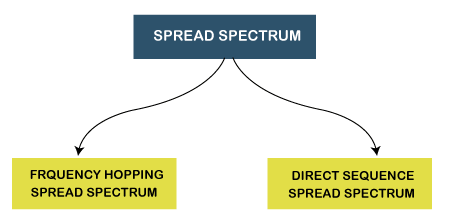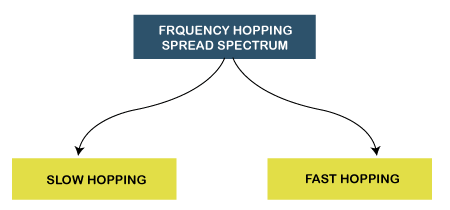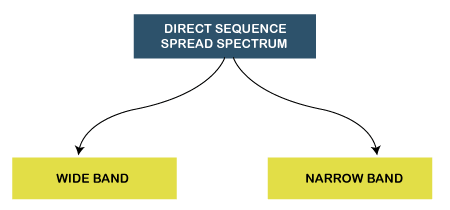Spread Spectrum in Mobile Computing
Spread spectrum is a technique used for wireless communications in telecommunication and radio communication. In this technique, the frequency of the transmitted signal, i.e., an electrical signal, electromagnetic signal, or acoustic signal, is deliberately varied and generates a much greater bandwidth than the signal would have if its frequency were not varied.
In other words, “Spread Spectrum is a technique in which the transmitted signals of specific frequencies are varied slightly to obtain greater bandwidth as compared to initial bandwidth.”
Now, spread spectrum technology is widely used in radio signals transmission because it can easily reduce noise and other signal issues.
Example of Spread Spectrum
Let’s see an example to understand the concept of spread spectrum in wireless communication:
We know that a conventional wireless signal frequency is usually specified in megahertz (MHz) or gigahertz (GHz). It does not change with time (Sometimes it is exceptionally changed in the form of small, rapid fluctuations that generally occur due to modulation). Suppose you want to listen to FM stereo at frequency 104.8 MHz on your radio, and then once you set the frequency, the signal stays at 104.8 MHz. It does not go up to 105.1 MHz or down to 101.1 MHz. You see that your set digits on the radio’s frequency dial stay the same at all times. The frequency of a conventional wireless signal is kept as constant to keep bandwidth within certain limits, and the signal can be easily located by someone who wants to retrieve the information.
In this conventional wireless communication model, you can face at least two problems:
- A signal whose frequency is constant is subject to catastrophic interference. This interference occurs when another signal is transmitted on or near the frequency of a specified signal.
- A constant-frequency signal can easily be intercepted. So, it is not suitable for the applications in which information must be kept confidential between the source (transmitting party) and the receiver.
The spread spectrum model is used to overcome with this conventional communication model. Here, the transmitted signal frequency is deliberately varied over a comparatively large segment of the electromagnetic radiation spectrum. This variation is done according to a specific but complicated mathematical function. If the receiver wants to intercept the signal, it must be tuned to frequencies that vary precisely according to this function.
Reasons to use Spread Spectrum
- Spread spectrum signals are distributed over a wide range of frequencies and then collected and received back to the receiver. On the other hand, wide-band signals are noise-like and challenging to detect.
- Initially, the spread spectrum was adopted in military applications because of its resistance to jamming and difficulty intercepting.
- Now, this is also used in commercial wireless communication.
- It is most preferred because of its useful bandwidth utilization ability.
Usage of Spread Spectrum
There are many reasons to use this spread spectrum technique for wireless communications. The following are some reasons:
- It can successfully establish a secure medium of communication.
- It can increase the resistance to natural interference, such as noise and jamming, to prevent detection.
- It can limit the power flux density (e.g., in satellite down links).
- It can enable multiple-access communications.
Types of Spread Spectrum
Spread Spectrum can be categorized into two types:
- Frequency Hopping Spread Spectrum (FHSS)
- Direct Sequence Spread Spectrum(DSSS)

Frequency Hopping Spread Spectrum (FHSS)
- The Frequency Hopping Spread Spectrum or FHSS allows us to utilize bandwidth properly and maximum. In this technique, the whole available bandwidth is divided into many channels and spread between channels, arranged continuously.
- The frequency slots are selected randomly, and frequency signals are transmitted according to their occupancy.
- The transmitters and receivers keep on hopping on channels available for a particular amount of time in milliseconds.
- So, you can see that it implements the frequency division multiplexing and time-division multiplexing simultaneously in FHSS.
The Frequency Hopping Spread Spectrum or FHSS can also be classified into two types:

- Slow Hopping: In slow hopping, multiple bits are transmitted on a specific frequency or same frequency.
- Fast Hopping: In fast hopping, individual bits are split and then transmitted on different frequencies.

Advantages of Frequency Hopping Spread Spectrum (FHSS)
The following are some advantages of frequency hopping spread spectrum (FHSS):
- The biggest advantage of Frequency Hopping Spread Spectrum or FHSS is its high efficiency.
- The Frequency Hopping Spread Spectrum or FHSS signals are highly resistant to narrowband interference because the signal hops to a different frequency band.
- It requires a shorter time for acquisition.
- It is highly secure. Its signals are very difficult to intercept if the frequency-hopping pattern is not known; that’s why it is preferred to use in Military services.
- We can easily program it to avoid some portions of the spectrum.
- Frequency Hopping Spread Spectrum or FHSS transmissions can share a frequency band with many types of conventional transmissions with minimal mutual interference. FHSS signals add minimal interference to narrowband communications, and vice versa.
- It provides a very large bandwidth.
- It can be simply implemented as compared to DsSS.
Disadvantages of Frequency Hopping Spread Spectrum (FHSS)
The following are some disadvantages of Frequency Hopping Spread Spectrum (FHSS):
- FHSS is less Robust, so sometimes it requires error correction.
- FHSS needs complex frequency synthesizers.
- FHSS supports a lower data rate of 3 Mbps as compared to the 11 Mbps data rate supported by DSSS.
- It is not very useful for range and range rate measurements.
- It supports the lower coverage range due to the high SNR requirement at the receiver.
- Nowadays, it is not very popular due to the emerging of new wireless technologies in wireless products.
Applications of Frequency Hopping Spread Spectrum (FHSS)
Following is the list of most used applications of Frequency Hopping Spread Spectrum or FHSS:
- The Frequency Hopping Spread Spectrum or FHSS is used in wireless local area networks (WLAN) standard for Wi-Fi.
- FHSS is also used in the wireless personal area networks (WPAN) standard for Bluetooth.
Direct Sequence Spread Spectrum (DSSS)
The Direct Sequence Spread Spectrum (DSSS) is a spread-spectrum modulation technique primarily used to reduce overall signal interference in telecommunication. The Direct Sequence Spread Spectrum modulation makes the transmitted signal wider in bandwidth than the information bandwidth. In DSSS, the message bits are modulated by a bit sequencing process known as a spreading sequence. This spreading-sequence bit is known as a chip. It has a much shorter duration (larger bandwidth) than the original message bits. Following are the features of Direct Sequence Spread Spectrum or DSSS.
- In Direct Sequence Spread Spectrum or DSSS technique, the data that needs to be transmitted is split into smaller blocks.
- After that, each data block is attached with a high data rate bit sequence and is transmitted from the sender end to
- the receiver end.
- Data blocks are recombined again to generate the original data at the receiver’s end, which was sent by the sender, with the help of the data rate bit sequence.
- If somehow data is lost, then data blocks can also be recovered with those data rate bits.
- The main advantage of splitting the data into smaller blocks is that it reduces the noise and unintentional inference.
The Direct Sequence Spread Spectrum or DSSS can also be classified into two types:
- Wide Band Spread Spectrum
- Narrow Band Spread Spectrum

Advantages of Direct Sequence Spread Spectrum (DSSS)
The following are some advantages of Direct Sequence Spread Spectrum or DSSS:
- Direct Sequence Spread Spectrum or DSSS is less reluctant to noise; that’s why the DSSS system’s performance in the presence of noise is better than the FHSS system.
- In Direct Sequence Spread Spectrum or DSSS, signals are challenging to detect.
- It provides the best discrimination against multipath signals.
- In Direct Sequence Spread Spectrum, there are very few chances of jamming because it avoids intentional interference such as jamming effectively.
Disadvantages of Direct Sequence Spread Spectrum (DSSS)
The following are some disadvantages of Direct Sequence Spread Spectrum or DSSS:
- The Direct Sequence Spread Spectrum or DSSS system takes large acquisition time; that’s why its performance is slow.
- It requires wide-band channels with small phase distortion.
- In DSSS, the pseudo-noise generator generates a sequence at high rates.
Applications of Direct Sequence Spread Spectrum (DSSS)
Following is the list of most used applications of Direct Sequence Spread Spectrum or DSSS:
- Direct Sequence Spread Spectrum or DSSS is used in LAN technology.
- Direct Sequence Spread Spectrum or DSSS is also used in Satellite communication technology.
- DSSS is used in the military and many other commercial applications.
- It is used in the low probability of the intercept signal.
- It supports Code division multiple access.
